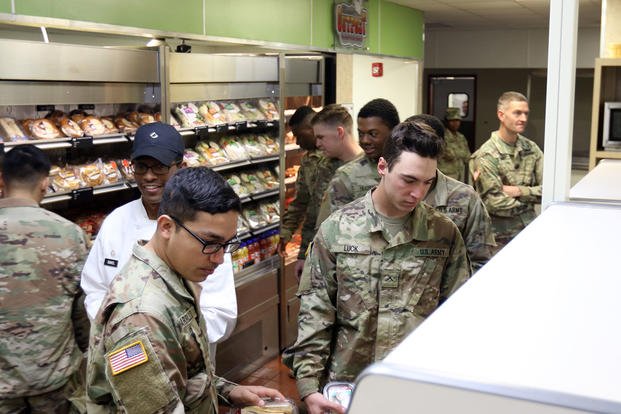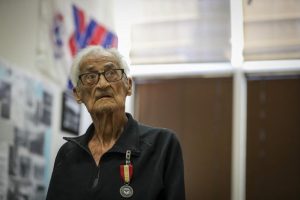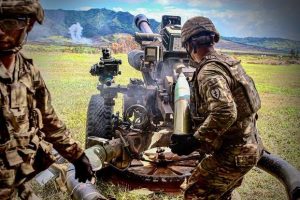The Army is doubling down on its so-called food kiosks on bases, a small setup in which soldiers can take snacks on the go, but the increased reliance has sparked concerns.
The kiosks are generally designed to serve 1,000 soldiers a day and offer an alternative or a supplemental food source apart from traditional dining facilities. In recent years, the Army has opened 14 of them, and plans to open an additional 13 within the next year, according to the service.
The minimalist food stations are akin to a snack shop at a gas station and are stocked with a basic assortment of chips, small desserts, soda, sushi, fresh fruit and sandwiches. All of that food is sourced from the respective installation’s commissary, including its deli. But many options are heavily processed, and soldiers have raised complaints of small portion sizes — the salad entree, for example, is under 300 calories.
Read Next: Army Lieutenant Colonel at Fort Belvoir Accused of More than 16 Allegations of Domestic Abuse, Assault
The shift to more food kiosks comes as the Army is struggling with what to do with its dining facilities, which were recently rebranded as “warrior restaurants.”
In many cases, soldiers are not using those dining halls in large enough numbers for Army planners to justify investing in the facilities, which require up to four dozen staff to operate.
Soldiers have also long complained about the food variety and quality and lack of nutrition, as well as sometimes dangerous and unsanitary conditions. It’s commonplace to find soldiers on social media posting images of raw chicken served to them, or small portion sizes.
The service declined an interview request with senior officials overseeing kiosk implementation for this story.
Army planners have spent the last half-decade drawing up blueprints to revamp how it feeds its force. Part of that included establishing food trucks at most of its major installations.
When it comes to dining facilities, the service looked into higher-quality food or investing in clean protein smoothie options. It also eyed allowing soldiers to use meal cards at restaurants on and off base, or at commissaries.
But none of those plans ever made much progress. Outside of meal card options, most food on base has limited healthy offerings, with fast food including Burger King and Popeyes being among the most common options.
The service has in some places, such as West Point, mastered feeding people en masse. The struggle has mostly been isolated to how it feeds its junior enlisted troops.
The kiosks are broadly seen, as some explained to Military.com, as meeting soldiers in the middle — offering food easier to take on the go while at the same time drastically cutting costs, requiring only two to three personnel to operate and shorter working hours.
Fort Carson, Colorado, is among the bases most invested in kiosks, opening its newest one earlier this month and planning for a third to debut in April.
“We are picking up fresh food for those daily,” said Chief Warrant Officer 3 Amanda Hoxie, who oversees the kiosks there. “We’re trying to modernize. A lot of this generation went through COVID, and soldiers have gotten comfortable sticking to their rooms. That has become normal. Even at [dining facilities], they’ll take to-go plates; they want to go to their own space.
“At the kiosk, it provides those options to come in and go back to their space,” she said.
Hoxie said Fort Carson’s main dining facility will serve around 800 soldiers for lunch and only about 300 for dinner. On the weekends, that attendance dips further and rarely hits 200.
Those relatively low numbers are broadly comparable to other major bases. The first weekend the new kiosk was open, it served 300 soldiers. Last weekend, it served around 700 — a huge hit that could be a result of the convenience, and soldiers checking out the new thing on post.
That kiosk is stocked with food from the commissary, featuring sandwiches and wraps made at the deli there. Soldiers interviewed all agreed they liked the idea of the kiosk, but were disappointed with the food offered, particularly with the portion sizes and nutritional options.
“This is more of a snack,” one noncommissioned officer told Military.com on the condition of anonymity because they were not authorized to talk to the press. “Most of this stuff is unhealthy, and the stuff that is sorta good for you are in such small portions, it’s not helping me or my soldiers.”
A Military.com review of the menu found that much of the food was heavy in sugar, carbs and sodium. Troops are allowed to take home a day’s worth of meals, with each consisting of a small pre-made salad, a sandwich or frozen meal. They also come with a choice of fruit, chips or granola bar; a dairy product that can be a stick of cheese or milk; a dessert; and a drink such as soda.
The service’s guidance on nutrition says male soldiers should get about 136 grams of protein each day, on average. The different combinations of the kiosk menu appear to make that goal difficult — and even harder without also consuming a significant amount of sugar.
Based on a review of the menu options, hitting that protein recommendation would likely require the soldier to drink a Nesquik milk each meal that offers 15 grams of protein — but also 18 grams of sugar — and a tuna pack with 4 grams of sugar. The American Heart Association recommends men have no more than 36 grams of added sugar per day.
The Army has invested heavily into its health and fitness culture in recent years, establishing a more comprehensive physical fitness test and putting more resources into mental health care, but it was never able to wrap its arms around nutrition, several Army staff and senior officials explained to Military.com.
“It’s a chicken and egg thing,” one senior official involved in the Army’s planning process to establish kiosks explained. “We nailed the [fitness test], but just never got around to nutrition. Soldiers not using [dining facilities] makes it hard to justify investment. But … they have barriers; it’s hard for some soldiers to get to them. The food also isn’t great.”
Some bases are having a hard time keeping dining facilities open. In the case of Fort Cavazos, Texas, the base was able to consistently keep only two of its 10 dining facilities open during much of last summer — forcing many soldiers to drive long distances across base that could amount to an hour round trip for their meals.
But junior enlisted troops often do not have vehicles, and on-base shuttle services are unreliable, soldiers interviewed say. Many installations do not have a comprehensive schedule of their dining facilities posted online and, in many cases, those schedules are not accurate.
While the future of how the Army feeds its force is in the air, it’s still seeking feedback on the kiosks, including what they should be stocked with, as the idea is still in its infancy. But one thing is for sure: They won’t carry booze or tobacco.
“I was not able to add beer,” Hoxie, who oversees the kiosks at Carson, added. “I saw requests for that and cigarettes. I can’t touch that.”
Related: Fort Cavazos Soldiers Have Been Without Proper Access to Food for Months
Story Continues
Please rate this CIBA article
Vote






